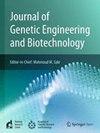Deciphering genetic relationships within and among banana (Musa spp.) genome groups using ISSR and SRAP markers
IF 2.8
Q3 Biochemistry, Genetics and Molecular Biology
Journal of Genetic Engineering and Biotechnology
Pub Date : 2025-07-21
DOI:10.1016/j.jgeb.2025.100540
引用次数: 0
Abstract
Characterization and identification of banana into their correct genome groups has been a problematic issue based on morphological and unappropriated molecular markers. In the present study, the genetic relationship between and among 28 banana (Musa spp.) accessions representing 5 genome groups (AAA, BB, AAB, ABB and AB) were evaluated using sequence-related amplified polymorphism (SRAP) and inter simple sequence repeat (ISSR) markers. Although similar genetic relationship parameters were observed with the two markers, the higher values were generated with SRAP profiles as indicated with mean gene diversity value of 0.69 with SRAP and 0.64 with ISSR, polymorphic information content (PIC) of 0.64 with SRAP and 0.59 with ISSR, total genetic diversity (Ht) of 0.39 with SRAP and 0.34 with ISSR, gene diversity within population (Hs) of 0.19 with SRAP and 0.12 with ISSR, coefficient of gene differentiation (Gst) value of 0.51 with SRAP and 0.62 with ISSR and gene flow (Nm)value of 0.51 with SRAP and 0.31 with ISSR. The resulting dendrogram and the population structure also supports and showed the concurrence with the genetic relationship parameters based on the genome groups of the accessions studied. The present finding, also indicates the higher efficacy of SRAP markers over the ISSR markers in the discrimination of banana accessions based on their genome groups by grouping the banana accessions belonging to the different genome groups and ploidy levels. The present finding could be utilized for effective discrimination of banana accessions belonging to different genome groups.

利用ISSR和SRAP标记破译香蕉(Musa spp)基因组群内部和之间的遗传关系
基于形态学和不适当的分子标记,香蕉正确基因组群的鉴定和鉴定一直是一个有问题的问题。本研究利用序列相关扩增多态性(SRAP)和简单序列重复(ISSR)标记对香蕉(Musa spp.) 5个基因组群(AAA、BB、AAB、ABB和AB)的28个种质间的亲缘关系进行了分析。虽然两种标记的遗传关系参数相似,但SRAP谱的遗传多样性值更高,SRAP谱的平均基因多样性值为0.69,ISSR谱的平均基因多样性值为0.64,SRAP谱的多态性信息含量(PIC)为0.64,ISSR谱的多态性信息含量(PIC)为0.59,SRAP谱的总遗传多样性(Ht)为0.39,ISSR谱的总遗传多样性值为0.34,SRAP谱的群体内基因多样性值为0.19,ISSR谱的群体内基因多样性值为0.12。SRAP组基因分化系数(Gst)为0.51,ISSR组为0.62;基因流量(Nm)为0.51,ISSR组为0.31。所得到的树状图和群体结构也与基于所研究材料基因组群的亲缘关系参数一致。通过对不同基因组组和倍性水平的香蕉材料进行分组,本研究结果也表明SRAP标记在基于基因组组的香蕉材料鉴定中比ISSR标记具有更高的效率。本研究结果可用于不同基因组群香蕉材料的有效鉴别。
本文章由计算机程序翻译,如有差异,请以英文原文为准。
求助全文
约1分钟内获得全文
求助全文
来源期刊

Journal of Genetic Engineering and Biotechnology
Biochemistry, Genetics and Molecular Biology-Biotechnology
CiteScore
5.70
自引率
5.70%
发文量
159
审稿时长
16 weeks
期刊介绍:
Journal of genetic engineering and biotechnology is devoted to rapid publication of full-length research papers that leads to significant contribution in advancing knowledge in genetic engineering and biotechnology and provide novel perspectives in this research area. JGEB includes all major themes related to genetic engineering and recombinant DNA. The area of interest of JGEB includes but not restricted to: •Plant genetics •Animal genetics •Bacterial enzymes •Agricultural Biotechnology, •Biochemistry, •Biophysics, •Bioinformatics, •Environmental Biotechnology, •Industrial Biotechnology, •Microbial biotechnology, •Medical Biotechnology, •Bioenergy, Biosafety, •Biosecurity, •Bioethics, •GMOS, •Genomic, •Proteomic JGEB accepts
 求助内容:
求助内容: 应助结果提醒方式:
应助结果提醒方式:


